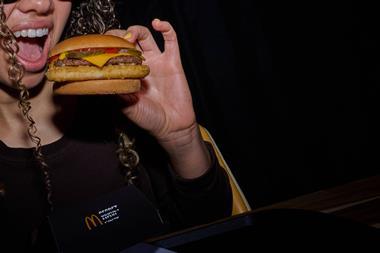What could be more logical? Families from disadvantaged communities need more help choosing a healthy diet, ergo small stores serving such communities are the salve for the country's obesity crisis. Get them to stock more salads and council estates across the land will be full of slim, fit and healthy people. Right?
The government certainly seems to think so. As it ramps up its efforts to combat an obesity crisis that is costing the NHS £1bn a year, it has moved the spotlight on from food and drink manufacturers and the supermarkets to the small independent retailer.
Last month public health minister Caroline Flint told The Grocer: "We always hear about the supermarkets but small, local stores can play an important role in healthy eating and diet."
These retailers play an important role in the community, yet have not engaged fully in the debate, partly, says Flint, because they do not have good access to consumer data and trends information. "Big supermarkets have huge amounts of money invested in data and marketing. Small retailers don't have the knowledge and expertise about healthy foods and trends that the big boys do. This feeds into their confidence."
She suggests the major multiples should share such information with smaller retailers.
It is clear, however, that government now expects to see some action from the independent sector.
"We are working with the British Retail Consortium and Association of Convenience Stores and want to see outcomes," says Flint.
Department of Health officials attended a discussion on the subject at a seminar organised by the ACS and BRC last month. Flint says this was helpful in getting the debate going. "Only when you sit down do you get to practicalities. Some solutions are easier than people think," she says.
Sainsbury's, The Co-operative Group and Tesco were also at the event, giving insight into changes they have made in convenience, while the Scottish Executive talked about its Healthy Living trial that is due to enter phase three under the umbrella of the Scottish Grocers Federation.
The executive has taken an interventionist approach, contributing £200,000 to develop the programme, training, point-of-sale material and merchandising equipment. Retailers including David Sands, Botterills and CJ Lang have been involved and results have been impressive, with healthy food sales up an average 60.9% in one retailer, including 82.6% in a low-income area , and fresh produce sales overall growing 4.3% faster than total business performance.
However, some independents are worried the government may take a prescriptive approach and the next battleground on health could be between the DH and small stores.
"It is not appropriate to move towards any form of guidelines," says James Lowman, incoming ACS chief executive. "Rather than imposing guidelines, it is better to discuss, share information on the opportunities and let retailers think about whether it is pertinent to their business."
He points to the limited space in a convenience store as well as logistics issues such as supply, wastage and managing the category.
The DH at least says it understands some of the threats to the profit base. Flint herself says: "What's in the way? The factors stopping these retailers introducing more fruit and vegetables are lack of space in-store, lack of confidence to take a risk to profitability and high wastage levels. But how many of these obstacles are merely perceived?" she asks.
Certainly some independents are seeing an increase in sales of healthy foods when testing them. Nigel Mills, MD of the Mills Group, has tested units dedicated to healthy snack-and-go products. He says sales of such products have leapt from an average of £60 a week to more than £500 a week per store - and margins are higher.
Sales of impulse confectionery are down £200 per week per store where the units have been introduced, however. That may be good news for the DH but a worry for suppliers in this category and potentially a longer-term issue for small retailers.
While Mills' experience is generally positive, the question is whether it is profitable for all small stores to introduce healthy foods at this stage.
Flint argues that evidence to date shows sales are generated. She points to the Healthy Start scheme, formerly Welfare Foods. The first phase of the new programme resulted in a 100% increase in the number of retailers involved compared with the old scheme and included the sale of fruit and vegetables as well as milk.
"Some retailers reported increased trade from both new and existing customers," says Flint. "Changing the habits of existing customers is important and the result of a wider range and choice. This first phase has been a win-win for families and retailers."
Lowman questions how much of an impact small retailers can make, however. "With only 25% of the market compared with the supermarkets' 75%, it is difficult to determine to quite what degree the marketing of such products by this sector will affect overall demand," he says. "Can we change behaviour? Small stores react to the demand rather than shape it."
Indeed, independents may even find an increase in sales of confectionery, soft drinks and crisps in those stores near bus stops and on the way home in view of the government's forthcoming ban on such foods in schools. And, with margins so tight, no small retailer is going to take out these products to test fruit and veg without a proven market.
The BRC has developed some principles for small retailers, including considering pricing and packaging of fruit as an alternative to sweets and engaging with communities to encourage demand for healthier foods. And Flint emphasises that this is about balancing the offer, not stopping the sale of crisps and confectionery. "Smaller store retailers recognise healthy is not a fad. It's helpful there is a much more sustainable discussion on how they can make healthier products more part and parcel of what they are providing."
But discussion is one thing - action quite another. While Spar, Budgens and Londis are well placed to exploit the health trend, getting the message to the thousands of proprietor-owned corner shops in the heart of communities is not easy. If suppliers and wholesalers often find it difficult to communicate to such retailers, how does government expect to do it?
And without support across the country comparable to that given by the Scottish Executive, it is hard to see how many independent small shop retailers will embrace a move to healthier products.n
45% of shoppers are buying more fresh produce now than 12 months ago
More than half of all shoppers state they would use their
c-store more if the range of healthy produce were improved
Fruit and veg contribute 2% to average total sales in a convenience store. In multiple c-stores it is as high as 10%
54% of shoppers had seen the Healthy Living logo and 28% thought it was intended to raise awareness of healthier eating
Stores in the Healthy Living project noted big increases in healthy food sales - in one retailer they were up 750% a week
Source: HIM Fresh CTP 2006
The government certainly seems to think so. As it ramps up its efforts to combat an obesity crisis that is costing the NHS £1bn a year, it has moved the spotlight on from food and drink manufacturers and the supermarkets to the small independent retailer.
Last month public health minister Caroline Flint told The Grocer: "We always hear about the supermarkets but small, local stores can play an important role in healthy eating and diet."
These retailers play an important role in the community, yet have not engaged fully in the debate, partly, says Flint, because they do not have good access to consumer data and trends information. "Big supermarkets have huge amounts of money invested in data and marketing. Small retailers don't have the knowledge and expertise about healthy foods and trends that the big boys do. This feeds into their confidence."
She suggests the major multiples should share such information with smaller retailers.
It is clear, however, that government now expects to see some action from the independent sector.
"We are working with the British Retail Consortium and Association of Convenience Stores and want to see outcomes," says Flint.
Department of Health officials attended a discussion on the subject at a seminar organised by the ACS and BRC last month. Flint says this was helpful in getting the debate going. "Only when you sit down do you get to practicalities. Some solutions are easier than people think," she says.
Sainsbury's, The Co-operative Group and Tesco were also at the event, giving insight into changes they have made in convenience, while the Scottish Executive talked about its Healthy Living trial that is due to enter phase three under the umbrella of the Scottish Grocers Federation.
The executive has taken an interventionist approach, contributing £200,000 to develop the programme, training, point-of-sale material and merchandising equipment. Retailers including David Sands, Botterills and CJ Lang have been involved and results have been impressive, with healthy food sales up an average 60.9% in one retailer, including 82.6% in a low-income area , and fresh produce sales overall growing 4.3% faster than total business performance.
However, some independents are worried the government may take a prescriptive approach and the next battleground on health could be between the DH and small stores.
"It is not appropriate to move towards any form of guidelines," says James Lowman, incoming ACS chief executive. "Rather than imposing guidelines, it is better to discuss, share information on the opportunities and let retailers think about whether it is pertinent to their business."
He points to the limited space in a convenience store as well as logistics issues such as supply, wastage and managing the category.
The DH at least says it understands some of the threats to the profit base. Flint herself says: "What's in the way? The factors stopping these retailers introducing more fruit and vegetables are lack of space in-store, lack of confidence to take a risk to profitability and high wastage levels. But how many of these obstacles are merely perceived?" she asks.
Certainly some independents are seeing an increase in sales of healthy foods when testing them. Nigel Mills, MD of the Mills Group, has tested units dedicated to healthy snack-and-go products. He says sales of such products have leapt from an average of £60 a week to more than £500 a week per store - and margins are higher.
Sales of impulse confectionery are down £200 per week per store where the units have been introduced, however. That may be good news for the DH but a worry for suppliers in this category and potentially a longer-term issue for small retailers.
While Mills' experience is generally positive, the question is whether it is profitable for all small stores to introduce healthy foods at this stage.
Flint argues that evidence to date shows sales are generated. She points to the Healthy Start scheme, formerly Welfare Foods. The first phase of the new programme resulted in a 100% increase in the number of retailers involved compared with the old scheme and included the sale of fruit and vegetables as well as milk.
"Some retailers reported increased trade from both new and existing customers," says Flint. "Changing the habits of existing customers is important and the result of a wider range and choice. This first phase has been a win-win for families and retailers."
Lowman questions how much of an impact small retailers can make, however. "With only 25% of the market compared with the supermarkets' 75%, it is difficult to determine to quite what degree the marketing of such products by this sector will affect overall demand," he says. "Can we change behaviour? Small stores react to the demand rather than shape it."
Indeed, independents may even find an increase in sales of confectionery, soft drinks and crisps in those stores near bus stops and on the way home in view of the government's forthcoming ban on such foods in schools. And, with margins so tight, no small retailer is going to take out these products to test fruit and veg without a proven market.
The BRC has developed some principles for small retailers, including considering pricing and packaging of fruit as an alternative to sweets and engaging with communities to encourage demand for healthier foods. And Flint emphasises that this is about balancing the offer, not stopping the sale of crisps and confectionery. "Smaller store retailers recognise healthy is not a fad. It's helpful there is a much more sustainable discussion on how they can make healthier products more part and parcel of what they are providing."
But discussion is one thing - action quite another. While Spar, Budgens and Londis are well placed to exploit the health trend, getting the message to the thousands of proprietor-owned corner shops in the heart of communities is not easy. If suppliers and wholesalers often find it difficult to communicate to such retailers, how does government expect to do it?
And without support across the country comparable to that given by the Scottish Executive, it is hard to see how many independent small shop retailers will embrace a move to healthier products.n
45% of shoppers are buying more fresh produce now than 12 months ago
More than half of all shoppers state they would use their
c-store more if the range of healthy produce were improved
Fruit and veg contribute 2% to average total sales in a convenience store. In multiple c-stores it is as high as 10%
54% of shoppers had seen the Healthy Living logo and 28% thought it was intended to raise awareness of healthier eating
Stores in the Healthy Living project noted big increases in healthy food sales - in one retailer they were up 750% a week
Source: HIM Fresh CTP 2006



















No comments yet